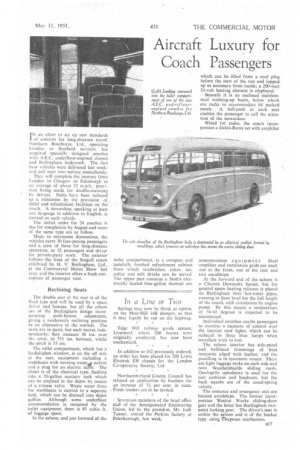Aircraft Luxury for Coach Passengers
Page 51

If you've noticed an error in this article please click here to report it so we can fix it.
I N an effort to set up new standards of comfort for long-distance travel, Northern Roadways, Ltd., operating London to Scotland services, has acquired specially designed coaches with AEC. underfloor-engined chassis and Burlingham bodywork. The first four vehicles were delivered last weekend and went into service immediately.
They will complete the journey from London to Glasgow or Edinburgh at an average of about 23 m.p.h., provision being made for double-manning by drivers. Halts have been reduced to. a minimum by the provision of, tb i let and refreshment facilities oh. the coach. A stewardess, speaking at least one language in addition to English, is carried on each vehicle.
The initial order for 24 coaches is due for completion by August and more of the same type are to follow.
Made to maximum dimensions, the vehicles carry 30 fare-paying passengers and a crew of three for long-distance operation, or 32 passengers and driver for private-party work. The exterior follows the lines of the Seagull coach exhibited by H. V. Burlingham, Ltd., at the Commercial Motor Show last year. and the interior offers a fresh conception of passenger ease.
Reclining Seats
The double seat at the rear is of the fixed type and will be used by a spare driver and 'hostess, but all the others are of the Burlingham design incorporating push-button adjustment, giving a moderately reclining position as an alternative to the normal. The seats are in pairs, but each moves independently; they measure 38 ins, over the arms, or 351 ins, between, whilst the pitch is 33 ins.
The toilet compartment, which has a leaded-glass window, is on the off side at the rear, equipment including a washbasin with running watera. mirror and a plug for an electric raW1r. The closet is of the chemical type, flushing into a 20-gallon sanitary tank which can be emptied at the depot by means of a release valve. Waste water from the washbasin is carried to a separate tank, which can be drained into depot gullies. Although some underfloor accommodation is occupied by the toilet equipment, there is 85 cubic ft. of luggage space.
In the saloon, and just forward of the
toilet compartment, is a compact and tastefully finished refreshment cabinet from which sandwiches, cakes, tea. coffee and soft drinks can be served. The upper part contains a Stott's electrically heated four-gallon thermal urn
which can be filled from a roof plug before the start of the run and topped up as necessary from inside; a 200-watt 24-volt heating element is eMployed.
Beneath it is an enclosed stainless
steel washing-up basin, below which are racks to accommodate 64 packed meals. A bell-push at each seat enables the passenger to call the attention of the stewardess.
Wired for radio, the coach incorporates a Delco-Remy set with amplifier announcement equipment. Dual amplifier and ventilation grids are used. one at the front, one at the rear and two amidships.
At the forward end of the saloon is a Clayton Dewandre heater, but for general space heating reliance is placed on Burlingham twin 'hot-water pipes, running at floor level for the full length of the coach, with circulation by engine pump. By this means a temperature of 58-60 degrees is expected to be maintained.
Individual switches enable passengers to exercise a measure of control over the interior roof lights, which can be reduced to three blue lamps when travellers wish to rest.
The saloon interior has side-panel and bulkhead trimmings of blue moquette edged with leather, and the panelling is in sycamore veneer. There are light luggage racks on each side and twin Weathershields sliding roofs. Dunlopillo upholstery is used for the seat cushions and headrests, but the back squabs are of the cased-spring variety.
The entrance and emergency exit are located amidships. The former incorporates Weston Works sliding-door gear and the latter has Burlingham two. point locking gear. The driver's seat is within the Saloon and is of the bucket type, using Chapman mechanism.




























































































